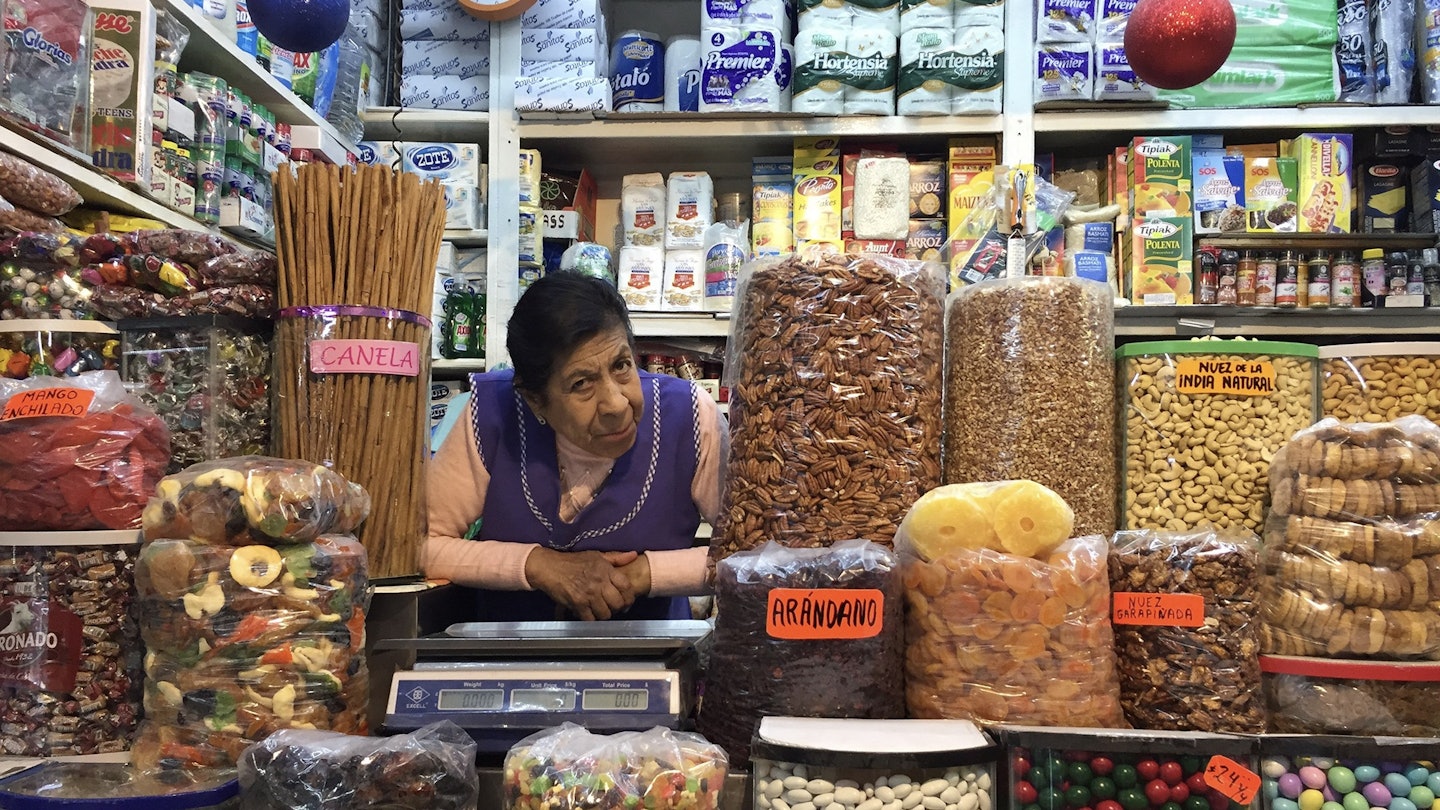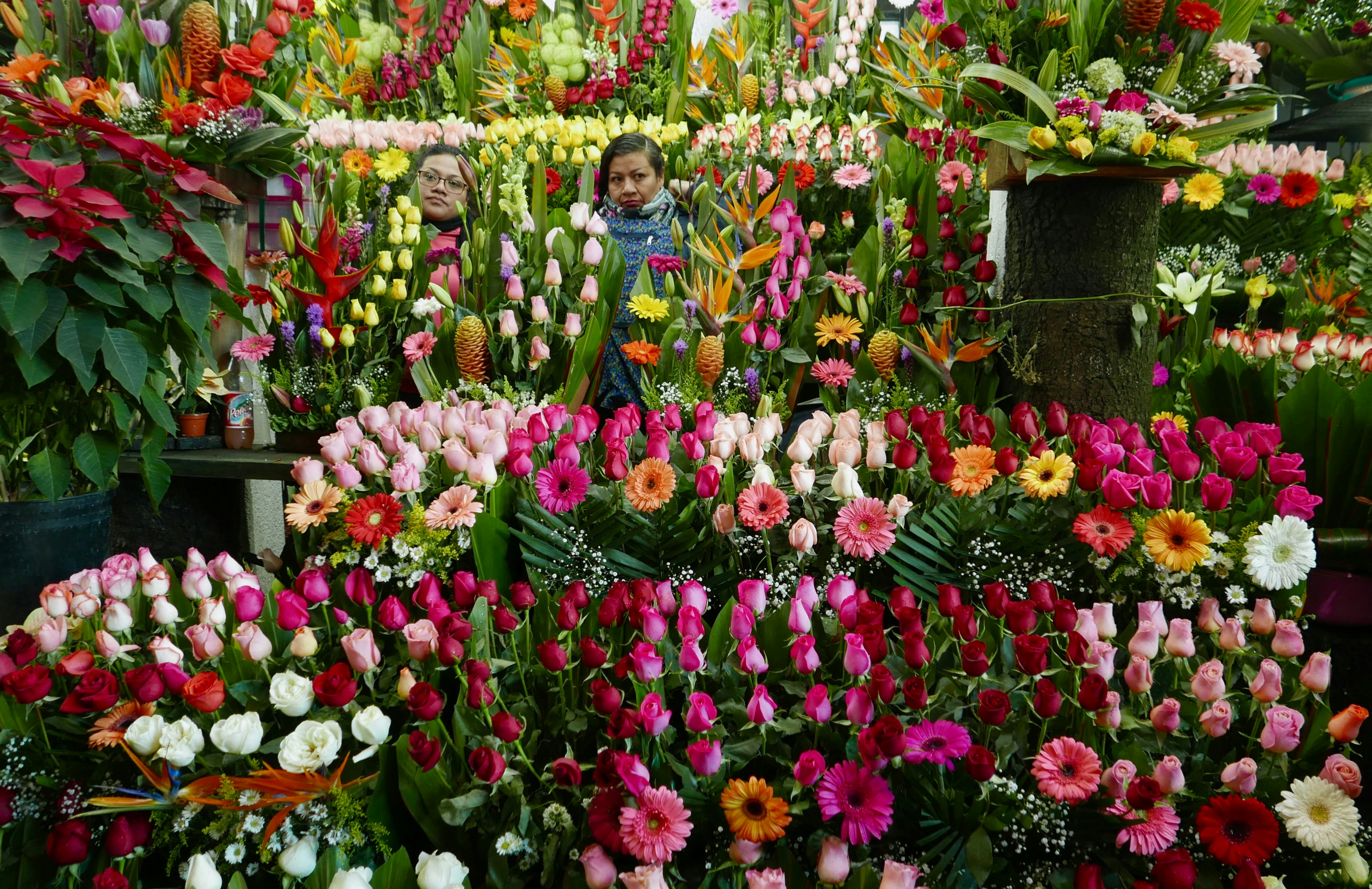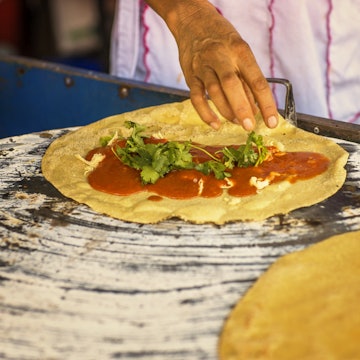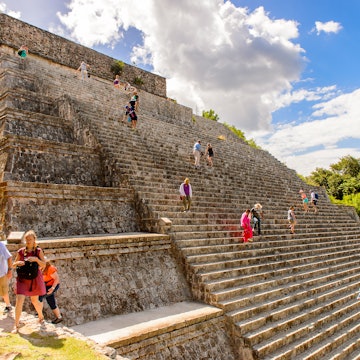

Mexico City’s fabled food culture comes to glorious life at its hundreds of food markets. Ray Mark Rinaldi/Chicago Tribune/Tribune News Service via Getty Images
The 400 or so public markets in Mexico City are where the city’s fabled food culture comes to life, where culinary traditions get disseminated and find new expression.
Indeed, these crucial social and economic spaces are where millions of people eat, work, shop and network daily – in a manner that has remained relatively unchanged over the city’s 700-year history, as it evolved from Mexica-ruled Tenochtitlan to Spanish colonial capital to modern metropolis of more than 22 million people.
Complementing its public markets are CDMX’ countless tianguis, temporary markets at which vendors take over designated streets on a specific day of the week to sell produce, prepared food, housewares and various other goods. (The term comes from the Nahuatl word tiankistli, meaning “market.”) Almost every neighborhood in Mexico City has a tianguis day, which provides locals with quality ingredients and affordable food options alongside the permanent public markets.
There might be no better way to plunge into the culture and local life in North America’s largest city than by taking in its varied and vibrant, raucous and essential markets. Here’s how.

How to shop at a market in Mexico City
Cash is king. In Mexico City markets, paying with cards is almost impossible, so come prepared with plenty of pesos, ideally in small denominations.
Don’t barter. Haggling is not acceptable in Mexico. If you disagree with the price, move on.
Bring your own bags. Since 2019, Mexico City has banned single-use plastic bags. Bring your own tote to do your shopping.
Don’t touch. Only handle the fruits and vegetables you plan on buying.
No need to rush in the morning. Public markets are usually up and running by 9am. Tianguis start a bit later, around 10am, since vendors drive into each neighborhood and take time to set up their stands.
Mercado Medellín
The vibes
Located in Colonia Roma and open every day, this enclosed public market (officially known as Melchor Ocampo but referred to by everyone as Medellín) has resisted the neighborhood’s rapid gentrification. Vibrant and colorful, the market is renowned for delicious produce (including fruits, vegetables, flowers and meats), plus pantry staples and housewares. Thanks to vendors who stock products from throughout South America, Mercado Medellín draws members of the Venezuelan and Colombian communities as well as locals.
What to buy there
El Yucateco desde 1968 – run by Carlos Palma Estrada (“el Yucateco” himself) for almost 60 years – is a legendary stand dedicated to products and ingredients from the Yucatán. Stock up on achiote paste, fresh habanero chiles, cookies, candies, hot sauces, honey and more.
Where to eat
Almost every public market in Mexico City has an aisle with fondas, mom-and-pop eateries that offer daily menus for a fixed (and reasonable) price – around M$70 (US$3.50) a meal. Most fondas serve such Mexican classics as enchiladas, pozole, hot chicken soup and rice with a fried egg. Facing Coahuila St, Mercado Medellín’s food aisle offers a bustling row of back-to-back fondas. I’m a fan of Cocina Juanita e Hijas: try their mole enchiladas topped with crema, or the steak with chilaquiles. Finish the meal with an ice cream from Helados Chan Chan.
Getting there
Covering an entire block between Monterrey and Medellín Aves, Mercado de Medellín, is centrally located and an easy walk from most spots in Roma and Condesa. Mid-morning is the best time of the day to visit; the market closes at 6pm.

Mercado el 100
The vibes
Sunday is farmers-market day at Mercado el 100. For more than 14 years, this market has welcomed organic farmers from such nearby Mexican states as Hidalgo, Oaxaca, Puebla and Guerrero to a small plaza In Roma. Shoppers can stock up not only on fresh organic produce but also such other artisanal products as honey, preserves, fermented drinks, sauces and even foraged wild mushrooms.
What to buy there
Nuevos Horizontes is a certified organic farm from Hidalgo that sells restaurant-quality ingredients (indeed, many well-regarded chefs work closely with the outfit). Heirloom tomatoes, radishes, multi-colored carrots, beets, squashes and leafy greens compose the weekly selection here.
Where to eat
A couple of stands sell food, the most famous being Otzilotzi, a family-run outfit that offers vegetable-stew tacos with handmade tortillas. Look out for the stand with many clay pots filled with fresh-looking stews, made from everything from wild mushrooms with mole to quelites and squash blossoms.
Getting there
Mercado el 100 is at the far end of Orizaba St. Come on the early side – it’s open from 9 am to 2pm – since the best products are picked up right away.

Mercado de Jamaica
The vibes
Flower lovers and connoisseurs will love Mexico City’s largest floral market. Located in the Cuauhtémoc district, Mercado de Jamaica houses more than 1000 vendors associated with the flower business – everything from wholesalers to florists specializing in weddings, funerals, birthdays…you name it. Adjoining the flower section, the enclosed market offers the standard array of food stands, butcher shops and pantry goods.
What to buy there
Mercado de Jamaica’s core business includes flowers, pots, ornamental plants, floral bouquets and elaborate arrangements. Produce is available in the second section of the market, with a couple of stands selling clay pots, dishes and molcajetes between the produce market and the enclosed area. In that same aisle, some vendors sell beautiful long white candles designed as church ornaments; they look beautiful on the dinner table, too.
Where to eat
A longtime local favorite, La Güera is famous for its corn on the cob with mayo and chili powder, as well as esquites (corn kernels in a cup with mayo and chili powder). Find it at the entrance of the market, at the corner of Guillermo Prieto St and Eje 2 Oriente Ave. La Güera’s creations have evolved throughout the years, taking a creative path with options like a Dorito-breaded corn called DoriElote, or the “esqui-ramen,” a platter with esquites, yellow cheese and mayo topped with ramen instant noodles.
Getting there
The market is just steps from the Jamaica station on Metro line 9 (brown); I’d recommend avoiding rush hour and planning a visit for between 10 and 11am. Taking an Uber is also an option, though traffic is hectic around the area.

Mercado de San Juan
The vibes
While Mercado de San Juan (also called Ernesto Pugibet) is known for its specialized Asian ingredients, quality seafood, wild game and European cheeses, it doesn’t feel upscale. Its reputation for gourmet fare has landed it on the tourist circuit, yet it also draws people from the surrounding neighborhood, as well as members of the Korean and Chinese communities. Indeed, many stalls have signs in these languages to cater to these shoppers.
What to buy there
Tapas as well as baguettes with cheese and deli meats are big things in Mercado San Juan. Several vendors focusing on European cheeses have branched out to selling tapas with a glass of wine; perhaps the most famous vendor is Las Tapas de San Juan (formerly known as La Jersey), located at stand 195. Other specialized products at Mercado San Juan include wild mushrooms (during the summer months), plus wild game like venison, wild boar and pigeon.
Where to eat
Chef Alan Villeda grew up learning the secrets of fresh seafood at his family’s fish stand. Today, besides selling fresh tuna, lobster, red snapper and shellfish, Villeda prepares delicious seafood tostadas, ceviche, sashimi and prepared clams at Cabo San Juan, a favorite of both locals and fellow chefs. The menu changes constantly based on product availability; arrive early as there can be as long as a 40-minute wait for a seat.
Getting there
From anywhere in the Centro Histórico, walking to the market is the best option. It’s about a 10-minute walk from Palacio de Bellas Artes.

Mercado de Coyoacán
The vibes
The neighborhood of Coyoacán – once a separate village, later subsumed by the capital’s sprawl – draws locals and visitors thanks to its bohemian air and picturesque cobblestone streets. Coyoacán also has its market a couple of blocks from the central Fuente de los Coyotes and Jardín Centenario – and it’s an essential stop when visiting the area, alongside the Frida Kahlo and Leon Trotsky Museums. Mercado de Coyoacán is quite popular for its street-food stands, which focus on tostadas, huaraches and tacos. Count on visiting this market for lunch.
What to buy there
Mercado de Coyoacán is a shopping hub for the neighborhood and a popular destination for artisanal crafts and Mexican kitchen utensils – think wooden spatulas, baskets and molcajetes. Stands also sell traditional Mexican candies, like sugar skulls, tamarind paste and marzipan.
Where to eat
Mercado de Coyoacán is all about tostadas. Several stands focus on this dish, offering toppings like tinga de pollo, wild mushrooms, pork trotters, potato and chorizo, beef stew and many more. The tostada stands all look very similar – most have red-and-yellow signs with picture menus – and all claim to be the best and the original. Choose the one that appeals most to you; they’re all good.
Getting there
It can take up to 50 minutes to get to Coyoacán from areas like Roma, Condesa and Polanco via Uber. Unfortunately, there are no subway stations close to Coyoacán’s main plaza, so a taxi or rideshare is the best way to get there.

Tuesday and Friday tianguis in Condesa
The vibes
Get a taste of Mexico City’s tianguis at the vibrant and lively Condesa ones, which take place Tuesday and Friday. The Tuesday tianguis takes over several blocks on Pachuca St from Veracruz Ave to Juan de la Barrera St, while the Friday tianguis happens on a few blocks on Campeche St, between Tamaulipas and Nuevo León Sts. People from the neighborhood shop weekly at both tianguis, providing a sense of familiarity and community among visitors and vendors. Tianguis are great places to eat, with numerous vendors selling quesadillas, stew tacos and even barbacoa.
What to buy there
Tianguis offer fresh seasonal fruits, vegetables, mole paste, dry chiles, eggs and even ornamental plants. People visit butcher stands to buy chicken and meat, which are often of higher quality than at the supermarket.
Where to eat
You’ll frequently see several vendors of blue-corn quesadillas – recognizable by the large comal (a flat griddle) with a bucket of corn dough to the side. Squash blossom and mushroom quesadillas are sought-after breakfast orders at these stands. Just make sure to order your quesadilla “con queso” – since a Mexico City quesadilla does not necessarily come with cheese.
Getting there
The Tuesday tianguis is a block from Lardo, a popular restaurant in Condesa. Pin your location there and walk one more block; the tianguis is hard to miss. The Friday tianguis is listed in Google Maps under Tianguis de los Viernes.
















